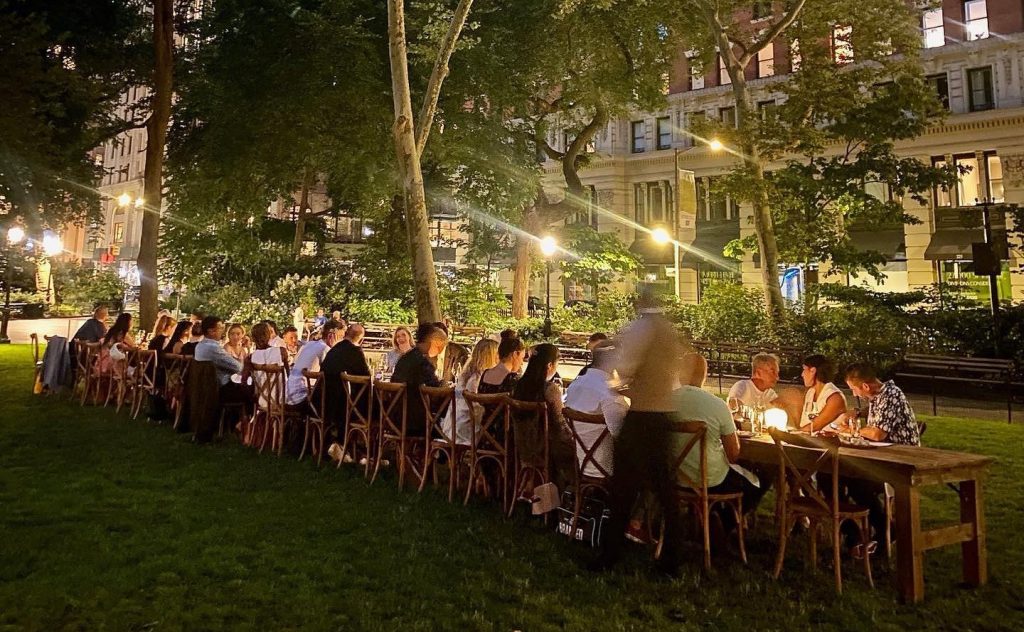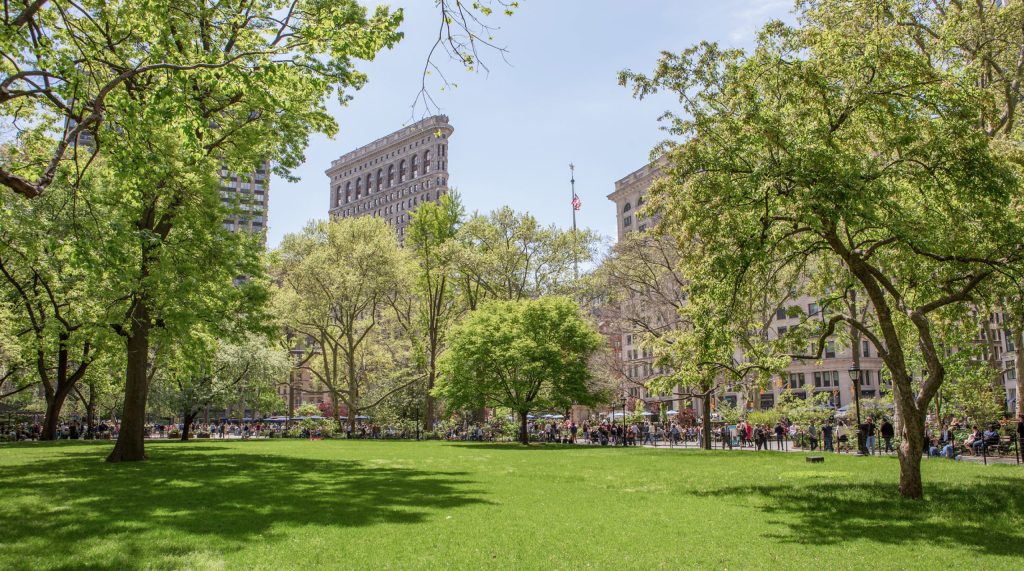Servicio de comidas respetuoso con el clima con Madison Square Park Conservancy

Conservación del Parque Madison Square (MSPC), una organización sin ánimo de lucro responsable del cuidado del espacio verde de 6,2 acres en el corazón de la ciudad de Nueva York que comparte su nombre, se dedica a nutrir los ecosistemas de su parque al tiempo que reduce las emisiones de carbono y proporciona liderazgo comunitario en materia de reducción de residuos y consumo.
Situado en los distritos Flatiron y NoMad de Manhattan, el parque recibe casi 60.000 visitantes al día.
Amado por su rara colección de Hamamelis (avellanos de bruja), el MSPC se dedica a ampliar su inclusión de una variedad de especies de plantas no sólo para proporcionar un oasis verde para los visitantes, sino también para educar al público sobre los impactos positivos de las colecciones específicas dentro del parque y la comunidad en general. El parque también acoge varios programas y exposiciones de arte climático, muchos de ellos creados con materiales sostenibles y centrados en acciones respetuosas con el clima. La divulgación del MSPC va más allá para garantizar que sus esfuerzos de conservación no se limiten a los límites del parque, sino que se extiendan también a la comunidad.

Destinos gastronómicos ecológicos
Madison Square Park Conservancy se ha asociado desde 2020 con los restaurantes de los alrededores de Nueva York para que su barrio sea designado "Destino gastronómico ecológico." Un Green Dining Destination se caracteriza por un total de 20 restaurantes locales que se inscriben colectivamente y cumplen los requisitos específicos establecidos por la Green Restaurant Association (GRA) para obtener la "Certificación Verde". Como se indica en el sitio web de la GRA, "la certificación exige que los restaurantes adopten medidas concretas para reducir su impacto ambiental, e incluye acciones como la eliminación de artículos de un solo uso, el compostaje de residuos alimentarios y la reducción del consumo de energía."
A través de Flatiron NoMad Partnership, MSPC puede conectar con restaurantes locales. Emily Dickinson, Directora de Sostenibilidad de Madison Square Park Conservancy, explicó el proceso de la campaña de divulgación a la comunidad local: "Empezamos compartiendo un paquete de marketing que incluye los beneficios que los restaurantes pueden recibir por participar. Invitamos a los propietarios o gerentes de los restaurantes a reunirse con nosotros personalmente para conocer más a fondo el impacto que la adhesión podría tener en la comunidad, y hemos celebrado sesiones informativas". Emily explica que, a continuación, los restauradores se reúnen con la GRA para revisar las normas de certificación e iniciar el proceso de certificación.
Pero, ¿cuáles son exactamente los beneficios de la certificación para el propio restaurante? Por nombrar algunos: reducción de la huella de carbono, disminución de los residuos y del consumo de agua y energía, reducción de los costes asociados, inclusión en actos y materiales de la comunidad para mostrar sus esfuerzos y aumento de la clientela concienciada con el medio ambiente. La relación entre el MSPC y los restaurantes va más allá del proceso de certificación, ya que tanto el MSPC como Flatiron NoMad organizan programas y actos al servicio de la comunidad. Emily señala que todos los restaurantes son bienvenidos al programa: "Cualquier restaurante, desde un camión de tacos veganos hasta un asador, puede optar a la certificación".
Certificación ecológica
La certificación ecológica conlleva normas de certificación establecidos por la GRA separados en categorías de energía, agua, residuos, reutilizables y desechables, productos químicos y contaminación, alimentos, construcción y mobiliarioy educación y transparencia. . Existen 4 niveles de certificación, definidos por un sistema de calificación de una a cuatro estrellas basado en la acumulación de puntos por acciones específicas realizadas. El gráfico de este desglose puede verse a continuación. La intención de las normas GRA es servir de medida transparente de los logros personales de cada restaurante y, al mismo tiempo, medir los pasos adicionales que pueden dar para mejorar sus prácticas sostenibles. También es posible que un candidato reciba una o más insignias de celebración, incluyendo residuos casi nulos, productos químicos limpios, vegano, vegetariano, marisco sostenibleo SustainaBuildTM.

Profundizar en las normas
En Normativa energética se divide en las categorías de calefacción/refrigeración/ventilación, calentamiento de agua, iluminación, equipos de cocina para cocinar, equipos de cocina para refrigerar, mantenimiento anual, varios, producción de electricidad in situ y créditos de energía renovable. Los puntos obtenidos en esta norma van desde 1 (por atributos como ventanas contra tormentas, ventiladores de techo y parrillas de infrarrojos) hasta 380 (por generación de electricidad renovable in situ, solar o eólica).
En Norma del agua se desglosa en las categorías de Reciclaje, Reducción de residuos, Desvío de residuos alimentarios, Reducción de residuos alimentarios y Educación y formación. Los puntos obtenidos en esta norma van de 1 (para atributos como urinarios de alta eficiencia, inodoros de doble descarga y jardines de lluvia) a 17,5 (para woks sin agua).
En Norma sobre residuos se desglosa en las categorías de Jardinería, Cocina, Baños y Otros. Los puntos obtenidos en esta norma van de 0,5 (por atributos como impresoras de doble cara, donación de muebles y envases a granel) a 20 (por residuos de alimentos reutilizados como comida para animales).
En Reutilizables y desechables Estándar se divide en las categorías de Limitación de residuos desechables, Reutilizables, Desechables de papel y alternativas reutilizables, Desechables adicionales y alternativas reutilizables, y Desechables compostables en un flujo de residuos de circuito cerrado. Los puntos obtenidos en esta norma van de 0,25 (para atributos como cartuchos de tinta rellenados o reciclados, desechables fabricados con contenido reciclado total 100% y desechables que cumplen un requisito de blanqueado obtienen los GreenPoints™ del nivel elegible más alto) a 100 (para Fast Casual/Fast Food 100% Reutilizables para artículos FOH).
En Norma sobre productos químicos y contaminación se divide en las categorías de selección de emplazamientos, gestión de aguas pluviales, contaminación lumínica, transporte y reducción de emisiones de petróleo, reducción de productos químicos, gestión de plagas y productos químicos. Los puntos obtenidos en esta norma oscilan entre 0,5 (para atributos como edificios situados a ¼ de milla de la línea de autobús, disponer de duchas in situ y tener una estación de scooters situada a ¼ de milla) y 25 (para la reurbanización de terrenos industriales abandonados).
En Norma alimentaria se divide en las categorías de opciones de menú veganas y vegetarianas, alimentos locales, marisco sostenible y alimentos y bebidas sostenibles. Los puntos obtenidos en esta norma van de 1 (por atributos como verduras/hierbas cultivadas in situ, alimentos locales obtenidos en un radio de 300 millas y alimentos ecológicos certificados por el USDA) a 100 (por porcentaje de platos principales y alimentos veganos).
En Norma de construcción y mobiliario se desglosa en las categorías de mobiliario, telas y mercancías, revestimientos y adhesivos, materiales de construcción de interiores y artículos de construcción. Los puntos obtenidos en esta norma van de 1 (para un atributo como pinturas y revestimientos reciclados hasta 50%) a 8 (para mobiliario, ropa de personal y mercancías reutilizados o recuperados).
En Norma de Educación y Transparencia se divide en las categorías de Educación y Transparencia. Los puntos obtenidos en esta norma van de 0,5 (por un atributo como la publicación en las redes sociales sobre una certificación o recertificación) a 5 (por ser 90% de los miembros de la plantilla Empleados Acreditados de Restaurantes Verdes).
¿Quién ha obtenido la certificación ecológica de MSPC?
A día de hoy, MSPC ha ayudado a nueve restaurantes a obtener la certificación: Scarpetta, Barcade, Cerebros de miel, Blackbarn, Rezdora Osteria Emiliana, Hawksmoor, Corte americano, Bombay Sandwich Coy Shake Shack con Tarallucci e Vino en vías de certificación.

Conclusiones y próximos pasos
Michael Oshman, director general y fundador de la Asociación de Restaurantes Ecológicos, declaró: "'Es importante que abordemos todas estas categorías para que esta industria sea sostenible desde el punto de vista medioambiental'. Lo principal que falta es un fuerte sentido de urgencia sobre lo importante que es abordar estas cuestiones ahora. La buena noticia es que no tenemos que esperar a una tecnología futura. Estamos ayudando a los restaurantes ahora'".
Para trabajar con restaurantes y vendedores con el fin de reducir los residuos y las emisiones, es importante ponerse primero en contacto con los restaurantes y otros vendedores de alimentos de los alrededores. Juntos podrán fijar objetivos en los que trabajar. Cabe señalar que la implantación de prácticas sostenibles en la rutina diaria de un restaurante es esencial para empezar a alcanzar cualquier objetivo. Reducir los residuos de un solo uso, compostar y comprar productos locales son algunas ideas para empezar con buen pie.
Si su institución está interesada en colaborar con proveedores para reducir las emisiones y los residuos, póngase en contacto con Emily Dickinson en la dirección siguiente edickinson@madisonsquarepark.org. Más información aquí y en Flatiron NoMad's Plan de resumen de marketing completo.

Fuentes:
- https://madisonsquarepark.org/
- https://madisonsquarepark.org/park/conservancy/
- https://madisonsquarepark.org/community/news/2022/08/transforming-the-neighborhood-into-nycs-first-green-dining-destination/
- https://www.dinegreen.com/certification-standards
- https://flatironnomad.nyc/wp-content/uploads/2023/02/FN-MSPC-Green-Dining-Destination-Marketing-Summary.pdf






Comentarios recientes